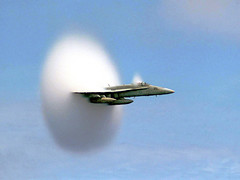Riding the Plasma Wave : 無料・フリー素材/写真
Riding the Plasma Wave / NASA Goddard Photo and Video
| ライセンス | クリエイティブ・コモンズ 表示 2.1 |
|---|---|
| 説明 | Caption: A cloud forms as this F/A-18 Hornet aircraft speeds up to supersonic speed. Aircraft flying this fast push air up to the very limits of its speed, forming what's called a bow shock in front of them. Similar bow shocks are also found in a variety of forms in space, and new research suggests they may contribute to heating of the material around them. Credit: Ensign John Gay, USS Constellation, U.S. Navy -----Throughout the universe more than 99 percent of matter looks nothing like what's on Earth. Instead of materials we can touch and see, instead of motions we intuitively expect like a ball rolling down a hill, or a cup that sits still on a table, most of the universe is governed by rules that react more obviously to such things as magnetic force or electrical charge. It would be as if your cup was magnetized, perhaps attracted to a metal ceiling above, and instead of resting, it floats up, hovering somewhere in the air, balanced between the upward force and the pull of gravity below.This material that pervades the universe, making up the stars and our sun, and also – far less densely, of course – the vast interstellar spaces in between, is called plasma. Plasmas are similar to gases, and indeed are made of familiar stuff such as hydrogen, helium, and even heavier elements like iron, but each particle carries electrical charge and the particles tend to move together as they do in a fluid. Understanding the way the plasma moves under the combined laws of motion we know on Earth and the less intuitive (to most Earthlings, at least) electromagnetic forces, lies at the heart of understanding the events that spur giant explosions on the sun as well as changes in Earth's own magnetic environment – the magnetosphere.Understanding this mysterious world of plasma, however, is not easy. With its complex rules of motion, the study of plasmas is rife with minute details to be teased out."Which particles are moving, what is the source of energy for the motion, how does a moving wave interact with the particles themselves, do the wave fields rotate to the right or to the left – all of these get classified," says Lynn Wilson who is a space plasma physicist at NASA's Goddard Space Flight Center in Greenbelt, Md.Wilson is the first author of a paper in Geophysical Research Letters that was published on March 12, 2012. Using data from the WAVES instrument on NASA's Wind mission, he and his colleagues have discovered evidence for a type of plasma wave moving faster than theory predicted it could move. The research suggests that a different process than expected, electrical instabilities in the plasma, may be driving the waves. This offers scientists another tool to understand how heat and energy can be transported through plasma.For the study, Wilson examined coronal mass ejections (CMEs) – clouds of solar material that burst off the sun and travel through space -- that move so much faster than the background solar wind that they create shock waves. These shock waves are similar to those produced by a supersonic jet when it moves faster than the speed of sound in our atmosphere."A bow shock is a little like a snow plow," says Adam Szabo, a space scientist at Goddard who is a co-author on the paper and also the project scientist for Wind. "The wave picks up particles that are traveling more slowly and speeds them up, piling them up in front as it moves." To read more go to: www.nasa.gov/mission_pages/sunearth/news/riding-plasma-wa...NASA image use policy.NASA Goddard Space Flight Center enables NASA’s mission through four scientific endeavors: Earth Science, Heliophysics, Solar System Exploration, and Astrophysics. Goddard plays a leading role in NASA’s accomplishments by contributing compelling scientific knowledge to advance the Agency’s mission.Follow us on TwitterLike us on FacebookFind us on Instagram |
| 撮影日 | 2012-07-11 13:51:21 |
| 撮影者 | NASA Goddard Photo and Video , Greenbelt, MD, USA |
| タグ | |
| 撮影地 |

